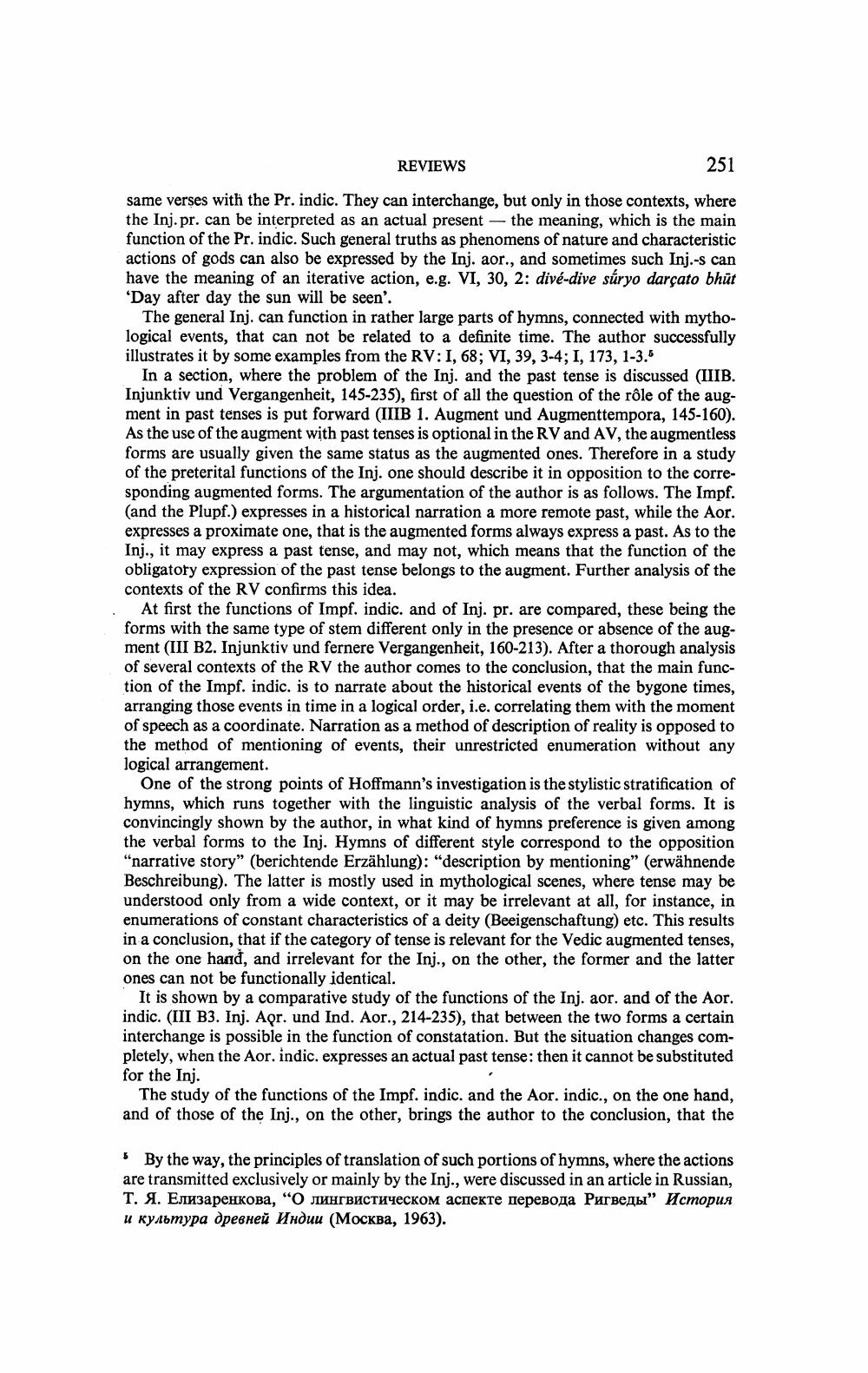Book Title: Reviews Of Different Books Author(s): Publisher: View full book textPage 5
________________ REVIEWS 251 same verses with the Pr. indic. They can interchange, but only in those contexts, where the Inj. pr. can be interpreted as an actual present - the meaning, which is the main function of the Pr. indic. Such general truths as phenomens of nature and characteristic actions of gods can also be expressed by the Inj. aor., and sometimes such Inj.-s can have the meaning of an iterative action, e.g. VI, 30, 2: dive-dive suryo darcato bhut 'Day after day the sun will be seen'. The general Inj. can function in rather large parts of hymns, connected with mythological events, that can not be related to a definite time. The author successfully illustrates it by some examples from the RV:1, 68; VI, 39, 3-4; 1, 173, 1-3.5 In a section, where the problem of the Inj. and the past tense is discussed (IIIB. Injunktiv und Vergangenheit, 145-235), first of all the question of the role of the augment in past tenses is put forward (IIIB 1. Augment und Augmenttempora, 145-160). As the use of the augment with past tenses is optional in the RV and AV, the augmentless forms are usually given the same status as the augmented ones. Therefore in a study of the preterital functions of the Inj. one should describe it in opposition to the corresponding augmented forms. The argumentation of the author is as follows. The Impf. (and the Plupf.) expresses in a historical narration a more remote past, while the Aor. expresses a proximate one, that is the augmented forms always express a past. As to the Inj., it may express a past tense, and may not, which means that the function of the obligatory expression of the past tense belongs to the augment. Further analysis of the contexts of the RV confirms this idea. At first the functions of Impf. indic. and of Inj. pr. are compared, these being the forms with the same type of stem different only in the presence or absence of the augment (III B2. Injunktiv und fernere Vergangenheit, 160-213). After a thorough analysis of several contexts of the RV the author comes to the conclusion, that the main function of the Impf. indic. is to narrate about the historical events of the bygone times, arranging those events in time in a logical order, i.e. correlating them with the moment of speech as a coordinate. Narration as a method of description of reality is opposed to the method of mentioning of events, their unrestricted enumeration without any logical arrangement. One of the strong points of Hoffmann's investigation is the stylistic stratification of hymns, which runs together with the linguistic analysis of the verbal forms. It is convincingly shown by the author, in what kind of hymns preference is given among the verbal forms to the Inj. Hymns of different style correspond to the opposition "narrative story" (berichtende Erzahlung): "description by mentioning" (erwahnende Beschreibung). The latter is mostly used in mythological scenes, where tense may be understood only from a wide context, or it may be irrelevant at all, for instance, in enumerations of constant characteristics of a deity (Beeigenschaftung) etc. This results in a conclusion, that if the category of tense is relevant for the Vedic augmented tenses, on the one hand, and irrelevant for the Inj., on the other, the former and the latter ones can not be functionally identical. It is shown by a comparative study of the functions of the Inj. aor. and of the Aor. indic. (III B3. Inj. Agr. und Ind. Aor., 214-235), that between the two forms a certain interchange is possible in the function of constatation. But the situation changes completely, when the Aor. indic. expresses an actual past tense: then it cannot be substituted for the Inj. The study of the functions of the Impf. indic. and the Aor. indic., on the one hand, and of those of the Inj., on the other, brings the author to the conclusion, that the 5 By the way, the principles of translation of such portions of hymns, where the actions are transmitted exclusively or mainly by the Inj., were discussed in an article in Russian, Т. Я. Елизаренкова, “о лингвистическом аспекте перевода Ригведы” История и культура древней Индии (Москва, 1963).Page Navigation
1 ... 3 4 5 6 7 8 9 10 11 12 13 14 15 16 17 18 19 20 21 22 23 24 25 26 27 28 29 30 31 32 33 34 35 36 37 38 39 40 41 42 43 44 45 46 47 48
